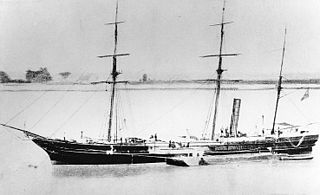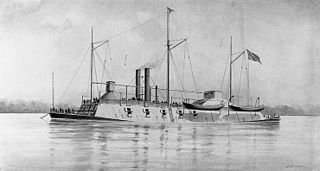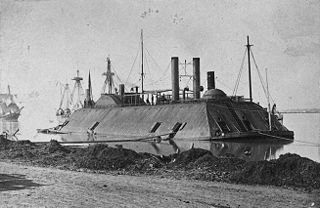
CSS Arkansas was the lead ship of her class of two casemate ironclads built for the Confederate States Navy during the American Civil War. Completed in 1862, she saw combat in the Western Theater when she steamed through a United States Navy fleet at Vicksburg in July. Arkansas was set on fire and destroyed by her crew after her engines broke down several weeks later. Her remains lie under a levee above Baton Rouge, Louisiana at 30°29′14″N91°12′5″W.

CSS McRae was a Confederate gunboat that saw service during the American Civil War. Displacing around 680 tons, she was armed with one 9-inch (229 mm) smoothbore and six 32-pounder (15 kg) smoothbore cannon.

The First Battle of Memphis was a naval battle fought on the Mississippi River immediately north of the city of Memphis, Tennessee on June 6, 1862, during the American Civil War. The engagement was witnessed by many of the citizens of Memphis. It resulted in a crushing defeat for the Confederate forces, and marked the virtual eradication of a Confederate naval presence on the river. Despite the lopsided outcome, the Union Army failed to grasp its strategic significance. Its primary historical importance is that it was the last time civilians with no prior military experience were permitted to command ships in combat. As such, it is a milestone in the development of professionalism in the United States Navy.

CSS Oregon was a wooden sidewheel steamer that served as a gunboat in the Confederate States Army during the American Civil War. Built in 1846 for the Mobile Mail Line, she transported mail between New Orleans, Louisiana, and Mobile, Alabama, before the war. In 1861, she was seized by the Governor of Louisiana, Thomas Overton Moore, and served as a blockade runner before being selected for use by the Confederate Army. After transferring men and supplies to Ship Island, she was formally converted into a gunboat and armed with four cannon. Remaining behind on Lake Pontchartrain when many Confederate warships were transferred up the Mississippi River, Oregon served in the Mississippi Sound and Pass Christian areas. She took part in several minor actions involving USS New London, two of which resulted in the Confederates moving into shallow water to avoid close-range action, and the third ending when the Confederate ships abandoned the Pass Christian area. In April 1862, Union pressure confined her and other Confederate ships to Lake Pontchartrain. Later that month, with Union forces closing in on New Orleans, Oregon was sunk as a blockship. Her wreck was removed and destroyed in the early 1870s.

CSS Manassas, formerly the steam icebreaker Enoch Train, was built in 1855 by James O. Curtis as a twin-screw towboat at Medford, Massachusetts. A New Orleans commission merchant, Captain John A. Stevenson, acquired her for use as a privateer after she was captured by another privateer CSS Ivy. Her fitting out as Manassas was completed at Algiers, Louisiana; her conversion to a ram of a radically modern design made her the first ironclad ship built for the Confederacy.

The USS Queen of the West was a sidewheel steamer ram ship and the flagship of the United States Ram Fleet and the Mississippi Marine Brigade. It was built at Cincinnati, Ohio in 1854. It served as a commercial steamer until purchased by Colonel Charles Ellet Jr. in 1862 and converted for use as a ram ship. The ship operated in conjunction with the Mississippi River Squadron during the Union brown-water navy battle against the Confederate River Defense Fleet for control of the Mississippi River and its tributaries during the American Civil War.

USS Cairo is the lead ship of the City-class casemate ironclads built at the beginning of the American Civil War to serve as river gunboats.

USS Benton was an ironclad river gunboat in the United States Navy during the American Civil War. She was named for American senator Thomas Hart Benton. Benton was a former center-wheel catamaran snagboat and was converted by James B. Eads, St. Louis, Missouri, in 1861 and commissioned February 24, 1862 as part of the Army's Western Gunboat Flotilla.

USS Varuna was a screw steamer acquired by the Union Navy during the American Civil War. Under construction in 1861, she was purchased incomplete on 31 December. After being commissioned in February 1862, she traveled to join the West Gulf Blockading Squadron. Varuna was present when Flag Officer David Glasgow Farragut led an attack against Confederate positions at Fort Jackson and Fort St. Philip on 24 April. During the action, Varuna ran ahead of the other Union ships, and was engaged in a chase with the Louisiana gunboat Governor Moore. After closing in on the Union ship, Governor Moore rammed Varuna twice, with the gunboat CSS Stonewall Jackson adding a third blow. Varuna sank within 15 minutes, but Farragut was able to capture the city of New Orleans, Louisiana.

The Battle of Elizabeth City of the American Civil War was fought in the immediate aftermath of the Battle of Roanoke Island. It took place on 10 February 1862, on the Pasquotank River near Elizabeth City, North Carolina. The participants were vessels of the U.S. Navy's North Atlantic Blockading Squadron, opposed by vessels of the Confederate Navy's Mosquito Fleet; the latter were supported by a shore-based battery of four guns at Cobb's Point, near the southeastern border of the town. The battle was a part of the campaign in North Carolina that was led by Major General Ambrose E. Burnside and known as the Burnside Expedition. The result was a Union victory, with Elizabeth City and its nearby waters in their possession, and the Confederate fleet captured, sunk, or dispersed.
CSS Louisiana was a casemate ironclad of the Confederate States Navy built to aid in defending the lower Mississippi River from invasion by the Union Navy during the American Civil War. She took part in one major action of the war, the Battle of Forts Jackson and St. Philip, and when that ended disastrously for the Confederacy, she was destroyed by her crew.

The battle of Forts Jackson and St. Philip was the decisive battle for possession of New Orleans in the American Civil War. The two Confederate forts on the Mississippi River south of the city were attacked by a Union Navy fleet. As long as the forts could keep the Federal forces from moving on the city, it was safe, but if they fell or were bypassed, there were no fall-back positions to impede the Union advance.
USS Sidney C. Jones was a schooner that served in the Union Navy during the American Civil War. Built in East Haddam, Connecticut, and launched in April 1856, Sidney C. Jones was intended to be used on trade routes. In October 1861, she was purchased by the Union Navy for military service. Originally intended for service on the Union blockade, she was later converted into a mortar schooner and was armed with a mortar and four other cannons. In April 1862, she participated in the bombardment of Confederate positions at Fort Jackson and Fort St. Philip. During July, she ran aground while part of a force bombarding Vicksburg, Mississippi, and was blown up by her crew to prevent capture on July 15.
CSS New Orleans was a floating battery used by the Confederate States Navy during the American Civil War. Converted from a floating drydock in 1861, she was commissioned on October 14, 1861. The vessel was unable to move under her own power and lacked facilities for her crew to live aboard, so CSS Red Rover was used to move the floating battery and house her crew. She was then sent upriver to assist in the Confederate defense of Columbus, Kentucky, arriving there in December. After the Confederates abandoned Columbus in March 1862, New Orleans was moved to Island No. 10 near New Madrid, Missouri. The Confederate defenders of Island No. 10 surrendered on April 8, and New Orleans was scuttled that day. Not fully sunk, the floating battery drifted downriver to the New Madrid area, where it was captured by Union forces. In Union hands, New Orleans was used as a floating drydock until the Confederates burned her in August or September 1863.

The Battle of the Head of Passes was a bloodless naval battle of the American Civil War. It was a naval raid made by the Confederate river defense fleet, also known as the “mosquito fleet” in the local media, on ships of the Union blockade squadron anchored at the Head of Passes. The mosquito fleet deployed three fire rafts, which were ignited and followed the ironclad ram CSS Manassas into the action. The attack occurred after moonset in the early hours of October 12, 1861, and routed the Union fleet, which fled in disorder down the Southwest pass of the delta. After sunrise Commodore George N. Hollins, running low on ammunition and fuel, ordered the mosquito fleet to withdraw upriver.

The Battle of Lucas Bend took place on January 11, 1862, near Lucas Bend, four miles north of Columbus on Mississippi River in Kentucky as it lay at the time of the American Civil War. In the network of the Mississippi, Tennessee and Ohio rivers, the Union river gunboats under Flag Officer Andrew Hull Foote and General Ulysses S. Grant sought to infiltrate and attack the Confederate positions in Tennessee. On the day of the battle, the Union ironclads Essex and St Louis, transporting troops down the Mississippi in fog, engaged the Confederate cotton clad warships General Polk, Ivy and Jackson and the gun platform New Orleans at a curve known as Lucas Bend in Kentucky. The Essex, under Commander William D. Porter, and the St Louis forced the Confederate ships to fall back after an hour of skirmishing during which the Union commander was wounded. They retreated to the safety of a nearby Confederate battery at Columbus, where the Union vessels could not follow.

CSS Pickens was a Cushing-class schooner revenue cutter that saw service in the navies of the United States and Confederate States of America. Built as Robert McClelland in Somerset, Massachusetts, in 1853, she served along the coasts of Louisiana and Texas before transferring her crew and officers to USRC Washington in 1859 and heading to New York for repairs. In 1860, Robert McClelland reported to South West Pass, Mississippi, and was permanently assigned to New Orleans, Louisiana, later that year. After the 1861 secession of Louisiana, her commander turned her over to the state. She entered Confederate service on February 18 and was renamed Pickens. Pickens played a minor role in the Battle of the Head of Passes before being burned to prevent its capture on April 25, 1862, after Union Navy forces entered New Orleans.
CSS Tuscarora was a sidewheel steamer that briefly served as a gunboat in the Confederate States Navy at the beginning of the American Civil War. She was about 100 feet (30 m) long, displaced 400 short tons, and was manned by a 25-man crew. The vessel was purchased in 1861 from the Southern Steamship Company by Confederate authorities in New Orleans, Louisiana. Armed with two cannons, Tuscarora was engaged in the Battle of the Head of Passes on October 12, 1861. Ordered up the Mississippi River to Columbus, Kentucky, in November, she was destroyed on November 23, 1861, when a fire of unknown origin started in her boilers and spread to the ship's munitions.
CSS Maurepas was a sidewheel steamer that briefly served as a gunboat in the Confederate States Navy during the American Civil War. Built in 1858 in Indiana as Grosse Tete, the vessel was used in commercial trade until 1860 and then delivered mail until 1861, when she was acquired by the Confederate Navy.
CSS Pontchartrain was a gunboat that served in the Confederate States Navy during the American Civil War. Built in 1859 for passenger and cotton trade, she was purchased by the Confederates in October 1862. After seeing action against Union land positions during the campaigns for New Madrid, Missouri, and Island Number Ten, she was transferred to serve on the Arkansas River and the White River. In June 1862, two of her cannons were taken to a land fortification at St. Charles, Arkansas, where part of her crew saw action in the Battle of St. Charles while manning the guns. Her other cannons were then offloaded at Fort Hindman, where more of her crew were captured while fighting on land at the Battle of Arkansas Post in January 1863. Pontchartrain herself remained inactive at Little Rock, Arkansas, and was burned to prevent capture in September 1863 when the Confederates evacuated the city.

















